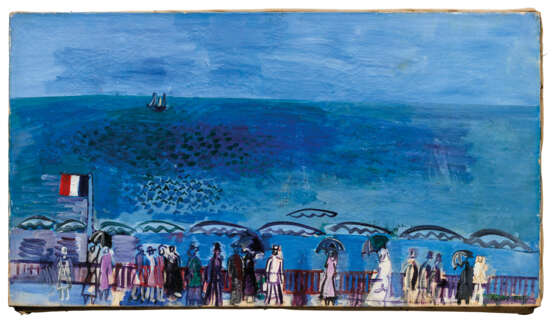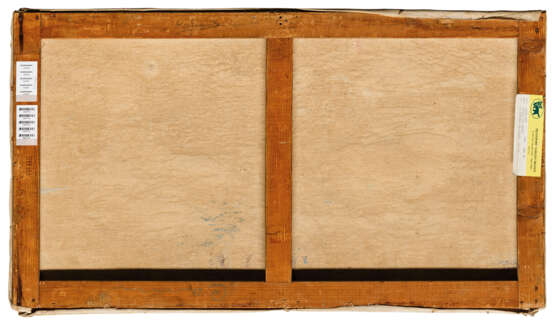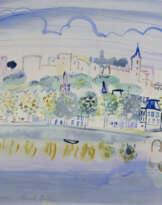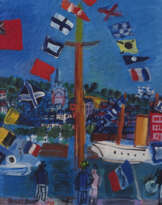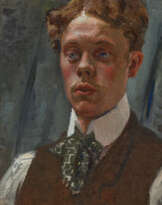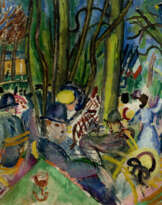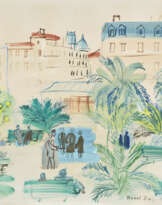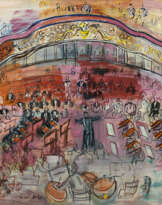ID 930317
Lot 130 | Raoul Dufy (1877-1953)
Estimate value
€ 80 000 – 120 000
Le Havre
signé 'Raoul Dufy' (en bas à droite)
huile sur toile
45 x 81 cm.
Peint vers 1924
signed 'Raoul Dufy' (lower right)
oil on canvas
17 3/4 x 31 7/8 in.
Painted circa 1924
Provenance
(probablement) Collection Rochegude (en 1944).
Galerie Joël Salaün, Paris.
Collection particulière, Paris (vers 1970).
Puis par descendance au propriétaire actuel.
Literature
M. Laffaille, Raoul Dufy, Catalogue raisonné de l'œuvre peint, Genève, 1973, vol. II, p. 48, no. 464 (illustré; titré 'Nice, la Promenade des anglais au drapeau').
Special notice
Artist's Resale Right ("droit de Suite").
If the Artist's Resale Right Regulations 2006 apply to this lot, the buyer also agrees to pay us an amount equal to the resale royalty provided for in those Regulations, and we undertake to the buyer to pay such amount to the artist's collection agent.
Post lot text
Ce tableau peint vers 1924 donne à voir l'un des sujets de prédilection de Raoul Dufy. Originaire du Havre, l'artiste revient sur les paysages normands tout au long de sa carrière. La présente huile représente sans doute une scène de fin d'été sur le front de mer havrais : sous un ciel mouvementé, quelques passants semblent s'être arrêtés pour contempler des bateaux qui tanguent dans le roulement lointain de la houle. Appliquées d'un geste ample et souple, les touches de bleus, de violets, de gris traduisent pleinement les nuances profondes des eaux agitées et la lumière froide, menaçante du climat capricieux.
En 1905, le coup d'éclat des Fauves au Salon d'Automne marque durablement l'esprit du jeune Dufy. Dans le sillage d'Henri Matisse, il adopte dès lors des couleurs très vives et des tracés fluides, plus enlevés. Albert Marquet l'emmène plus loin encore sur les sentiers du fauvisme en 1906 : cet été-là, les deux artistes séjournent ensemble en Normandie, peignant côte à côte Le Havre, Trouville, Honfleur et, notamment, le littoral de Sainte-Adresse.
Lorsque Dufy exécute cette vue du Havre dans les années 1920, il a déjà largement affirmé le style de sa maturité : des couleurs franches, éclatantes, alliées à des silhouettes très stylisées et des compositions schématiques qui évoquent l'effervescence de la vie moderne. C'est peut-être en songeant à l'évolution de sa propre démarche qu'il écrit ces mots dans son carnet de travail : « On peut passer une vie entière à peindre d'après nature, mais on peut aussi admettre qu'ayant compris, au fil d'années de pratique, les différentes apparences que peuvent revêtir les choses, et découvert à force d'analyse et de réflexion les causes principales qui sous-tendent les phénomènes de la lumière et de la couleur […] l'on ait pu se forger une méthode qui nous permette de nous exprimer, pinceau en main, sans devoir aller constamment vérifier l'apparence de telle ou telle chose, déjà tant de fois vérifiée auparavant » (Note manuscrite, in D. Perez-Tibi, Dufy, Londres, 1989, p. 139).
Painted circa 1924, Le Havre, depicts one of the most popular themes in the work of Raoul Dufy. A native of Normandy – Dufy was born in Le Havre – the artist had been painting this region since his early career. The present oil captures a scene seemingly from the end of summer: under a mercurial sky, a few passers-by have stopped to contemplate some boats, floating on a menacing sea. Using broad brushstrokes of blue, purple and grey, Dufy has managed to depict the deep, somber tones of agitated waters, as well as the menacing icy light of a volatile sky.
In 1905, the Fauvist exploit at the Salon d’Automne had strongly impressed the young Dufy, who embraced colours and flowing lines following the example of Henri Matisse. It was, however, Albert Marquet who showed Dufy the path towards Fauvism: the two artists spent the summer of 1906 painting together in Le Havre, Trouville and Honfleur, portraying, among other subjects, Sainte-Adresse.
By the time Dufy painted Le Havre, in the 1920s, however, he had found his own style: brilliant and direct colours are combined with simplified figures and schematic compositions, which vividly evoke the lively narratives of modern life. Perhaps commenting on the development of his own style, in one of his notebooks Dufy had observed: ‘One may paint from nature throughout one’s life, but one may also accept that, having learned by years of practice which have shown us all the outward appearances that things can assume, and having discovered, through analysis and reflection, the main cause behind the phenomena of light and colour […] you have been able to establish a system for yourself that enables you to express yourself, brush in hand, without being forced constantly to go back and check each individual thing checked so often before’ (Handwritten note, quoted in D. Perez-Tibi, Dufy, London, 1989, p. 139)
| Artist: | Raoul Dufy (1877 - 1953) |
|---|---|
| Applied technique: | Oil on canvas |
| Auction house category: | Paintings |
| Artist: | Raoul Dufy (1877 - 1953) |
|---|---|
| Applied technique: | Oil on canvas |
| Auction house category: | Paintings |
| Address of auction |
CHRISTIE'S 9 Avenue Matignon 75008 Paris France | ||||||||||||||
|---|---|---|---|---|---|---|---|---|---|---|---|---|---|---|---|
| Preview |
| ||||||||||||||
| Phone | +33 (0)1 40 76 85 85 | ||||||||||||||
| Fax | +33 (0)1 40 76 85 86 | ||||||||||||||
| Conditions of purchase | Conditions of purchase | ||||||||||||||
| Shipping |
Postal service Courier service pickup by yourself | ||||||||||||||
| Payment methods |
Wire Transfer | ||||||||||||||
| Business hours | Business hours
|

